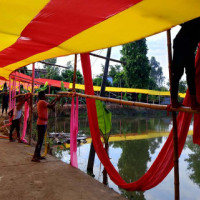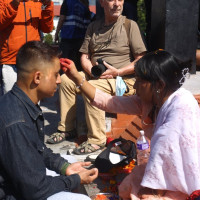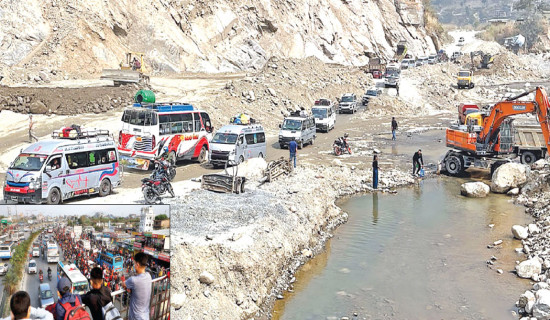- Friday, 24 October 2025
30% of Nepal Police units still in rented or makeshift spaces
Kathmandu, June 12: One does not need to travel far to witness the poor state of Nepal Police’s infrastructure. A short visit to the Kathmandu Valley Crime Investigation Office in Teku offers a revealing glimpse into the institutional hardship.
Since the devastating 2015 earthquake, this key office has been operating from a freely-given building spaces owned by Nepal Oil Corporation, highlighting the ongoing constraints faced by law enforcement even in the heart of the capital.
Previously, the Kathmandu District Police Range or the Kathmandu District Police Office operated from this same location. This Police Range office has now moved to a new state-of-the-art facility in Bhadrakali, Kathmandu from July 8, 2024. Until then, it too had been functioning from NOC’s property in Teku after the Range Office was displaced from Hanumandhoka following the building was declared unsafe.
According to Kaji Kumar Acharya, Superintendent of Police (SP) and Spokesperson for the Crime Investigation Office, Teku, his office had been using the NOC’s building free of cost as a new building is under construction just opposite to the current NOC’s land. Prior to this, the Crime Investigation Office had to operate from a rented room from Minbhawan, New Baneshwar, for more than three years, and after that, it again had to shift to Teku’s SaSa Banquet’s rented infrastructure, said SP Acharya.
The situation in the districts is even more disheartening. In Mugu’s Chainagaun, the local police post operates from a makeshift shed within a temple complex due to the absence of a proper building. Security officials spend their days and nights under that very shed, and any detainee must be taken to the District Police Office. Similarly, the Area Police Office in Lumaha, Salyan, is stationed in temple grounds due to a lack of government land.
In Jhapa’s Kichakbadh, police operate from a building provided by the local protection committee, while in Panchthar’s border post in Chyangthapu, the police unit is housed in a rented residence. Most police facilities in Panchthar remain in rented accommodations. With no proper lodging after long shifts of duty hour, personnel are forced to rest wherever they can.
These are not isolated cases but rather indicative of a nationwide crisis. Nepal Police currently has 2,660 police units across the country. Of the total police units, 1,896 units are operating in their own land and building, while 791 units have neither their own office nor land. To break down 791 units, 370 units are currently operating in rented rooms, and 421 are operating under other person’s institutions or personal land or property (like that of NOC).
Deputy Inspector General (DIG) and Spokesperson for the Police Headquarters, Binod Ghimire, said that based on the given data, 70 per cent of the total police units are operating in their own land and offices, while 30 per cent (791 units) still don’t have their own land and building causing many to operate in rented flats and in support of different organisations or institutions.
Similarly, in 843 units, there are no barracks at all. Even though there are barracks, 833 units do not have a mess hall for security personnel to eat.
Including the Police Headquarters and various units, there are approximately 20,000 personnel involved in internal management, important infrastructures, security of VIPs, training, and barrack-based structures. In addition, around 60,000 personnel are deployed from the headquarters to the local levels for tasks such as maintaining peace and security, crime investigation, prevention and control, disaster management, vehicle/traffic management, and strengthening citizen–police relations.
Although the Police Headquarters has approved total vacancies of 79,541, right now, there are 75,096 personnel in service. In remote districts like Mugu, Humla, Jumla, Kalikot, and Manang, police face further challenges during winter, often resorting to borrowing firewood from locals due to the lack of budget when they had to operate from rented flats and buildings provided by other institutions.
During the armed insurgency, 738 police buildings were damaged. Of these, over 635 buildings have so far been built across the country in different dates. Also, the 2015 earthquake demolished 196 more structures of Nepal Police, of which more than 100 infrastructures have so far been built, and others are still under construction, said the Headquarters.
Remote areas lack any formal police infrastructure. To remain near population centres, many units rent houses. This poses a challenge, “Where do we place detention cells in rented houses? How do we assign barracks for female officers? How can we manage a proper mess? These are real operational dilemmas,” said DIG Ghimire. “How can officers working 18-hour shifts function effectively without even a permanent office to report to?”
Former IGP Prakash Aryal remarked that, given the current level of government funding, it would take more than 15 to 20 years to renovate or reconstruct all decrepit police buildings nationwide.
According to police estimate, a District Police Office requires at least Rs. 150 million for construction, while an area or local unit needs Rs. 20 to 30 million to construct.















